-
San Diego sheriff: Migrants did not try to forcefully stop school bus - August 31, 2024
-
One stabbed, another injured in altercation on L.A. Metro bus - August 31, 2024
-
Trump Judge Has ‘Two Options’ as Future of Case Unclear: Analyst - August 31, 2024
-
What to Know About Putin’s Planned Visit to Mongolia Amid ICC Arrest Warrant - August 31, 2024
-
Buying sex from a minor could be a felony under bill headed to Newsom - August 31, 2024
-
Democrat Lawmaker Switches Party to Become Republican - August 31, 2024
-
Misdated Mail-In Ballots Should Still Count, Pennsylvania Court Rules - August 31, 2024
-
Cause and manner of death determined for Lucy-Bleu Knight - August 31, 2024
-
NASCAR Craftsman Truck Series Announces Return To Iconic Circuit In 2025 - August 31, 2024
-
At Pennsylvania Rally, Trump Tries to Explain Arlington Cemetery Clash - August 31, 2024
Being doored to death is a constant fear for city cyclists
The last time Yasmine Nasser Diaz spoke to her husband was in the early afternoon of Oct. 17 near their garage, where the couple stored their bicycles.
As Robert George, a Hollywood producer, walked his bike to the driveway of their Silver Lake home, Diaz popped out to pick up a delivery. She had received a package containing a new belt, and they shared a laugh over her excitement. After exchanging goodbyes, George took off for the gym.
At 3:30 p.m, Diaz, 46, received a call from the L.A. County-USC Medical Center notifying her that there had been an accident and that she “needed to come right away,” the artist told The Times. Three hours earlier, according to a police report, George had been “doored.”
“Dooring” and “doored,” colloquialisms among bicyclists, refer to a collision caused by a driver or passenger opening a car door into an oncoming cyclist. For some cyclists, such as Diaz, it is among their greatest fears. But collisions such as these, they say, can be prevented with greater awareness and better infrastructure.
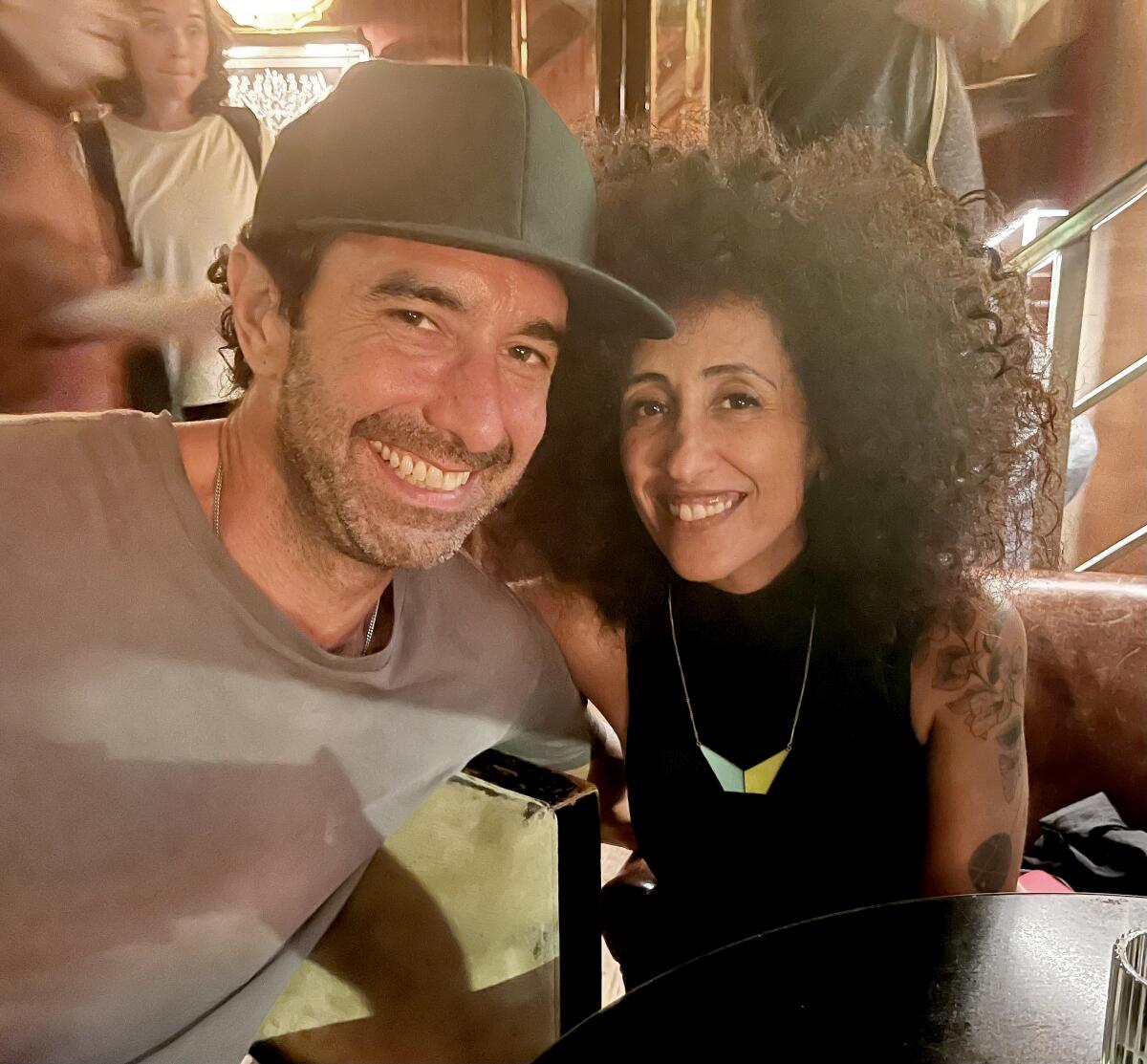
Robert George and Yasmine Nasser Diaz were together for 11 years after first meeting at the Silver Lake Jubilee.
(Yasmine Nasser Diaz)
Developing bike infrastructure in Los Angeles is complicated by logistics and competing interests. Bicyclists say L.A.’s car-centric culture hinders progress and argue that the city favors the comfort of drivers.
After being doored, George was flung by the impact onto North Edgemont Street in East Hollywood, where a second driver hit him, causing “traumatic head injuries,” the police report said. George was declared dead at 1:05 p.m., about an hour after the collision. He was 51.
“We were incredibly happy together and really excited about the future,” said Diaz, who described George as a “unicorn of a person, the most genuine and unconditionally supportive person” she’s ever known. “My world is totally shattered.”
In California, motorists are mandated to not open a door “unless it is reasonably safe to do so and can be done without interfering with the movement of such traffic,” according to the state vehicle code.
Nonetheless, drivers are “just not conscious” of cyclists and non-motorists on the road, mobility-justice advocate Yolanda Davis-Overstreet said.
“I truly think that the majority of people do not intend on opening their doors and slamming into a bicyclist,” Davis-Overstreet said.
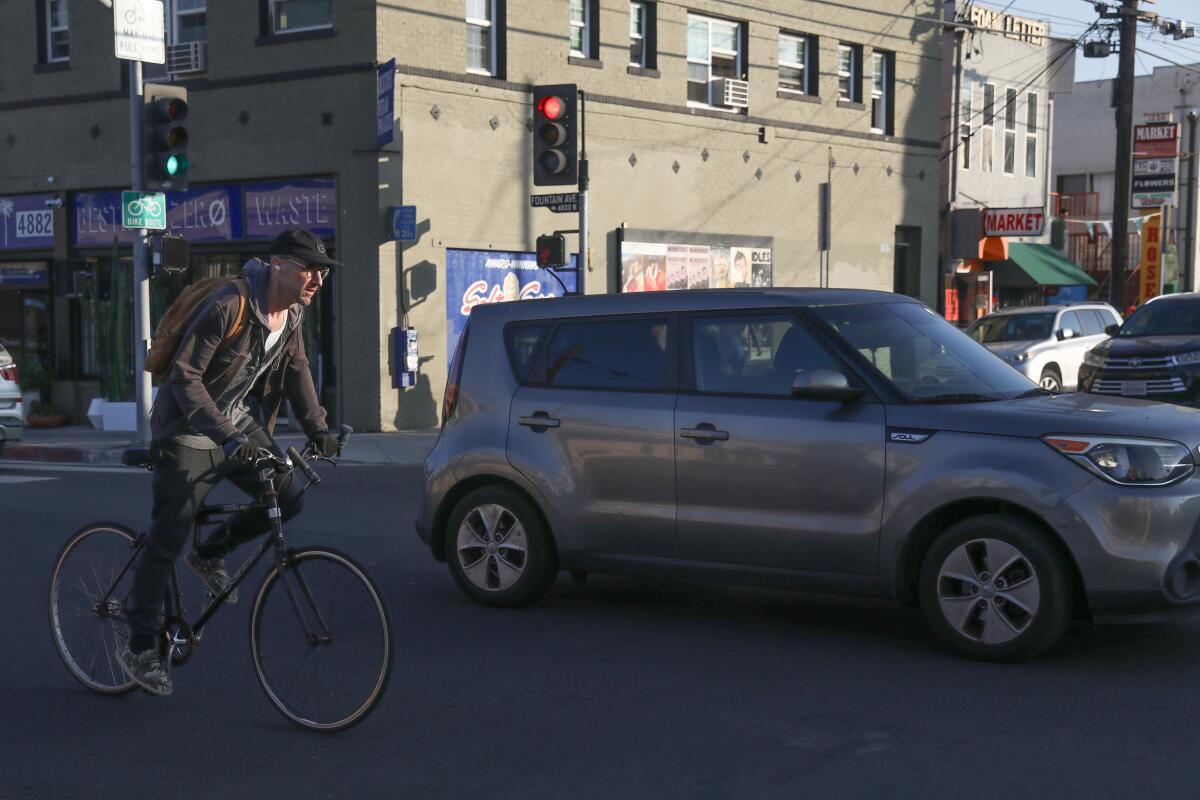
A cyclist rides through the busy intersection of Edgemont and Fountain Ave in Los Angeles, near where Robert George was struck by an opening car door.
(Michael Blackshire / Los Angeles Times)
But when car doors do collide with cyclists, the fallout can range from a few bumps and bruises to serious damage. Joshua Cohen, a personal injury attorney, said he’s dealt with cases in which cyclists had severed fingers, as well as back, neck and head injuries.
“The edge of the car door where it strikes the human body — generally, if you think about the physics of that happening — it’s almost like someone striking it with a sword because the leading edge of the car door is basically a thin piece of metal,” Cohen said.
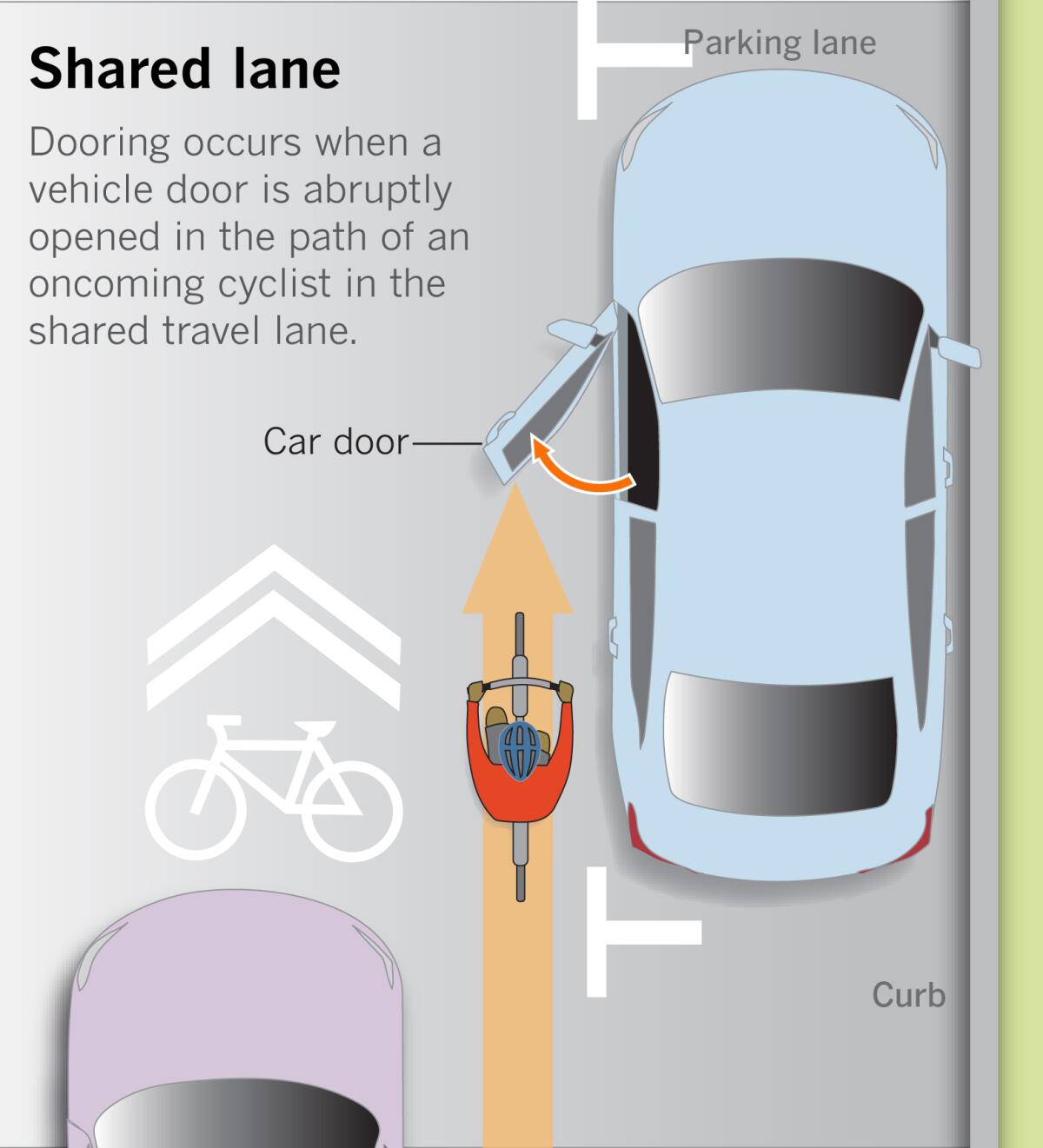
(Paul Duginski / Los Angeles Times)
Law enforcement will not arrest motorists who cause dooring collisions if no malicious intent can be proven, according to Los Angeles Police Department Capt. Benedict Fernandes, who serves in the West Traffic Division. In LAPD’s West Bureau, Fernandes said, there were 10 reported dooring collisions in 2022, two of which were severe. This year, there were only two reported incidents.
Upon hearing the numbers, Ken McLeod, the policy director for the League of American Bicyclists, laughed.
“These crashes aren’t reported because they are happening at the speed of the person on the bike, rather than the speed of a car hitting someone on a bike, since the car is stationary,” he said. “And since the lower speed and the mass of a bicyclist doesn’t create as much force, they might be less likely to create severe injury or death, which is often what’s reported.”
McLeod characterized dooring as an “underreported issue,” adding that it often “gets overlooked.” That’s why statistics are hard to come by.
“It definitely has a big psychological impact on people who bike,” McLeod said, “and it’s a terrible experience.”
Six years ago, Caro Vilain was doored by the driver of a FedEx van as she headed to work in Culver City.
Though Vilain, 31, usually stays “on the very edge of the bike lane” to prevent dooring, she rode closer to the right on Venice Boulevard that day to avoid speeding traffic. When the van’s door opened, Vilain said her “instinct kicked in.”
“I knew that there was a giant speeding SUV coming on my left, so I just couldn’t fall over, otherwise I probably wouldn’t be here,” Vilain, a video editor, said. “I just threw myself into the door and pushed through and managed to basically stay up.”
The driver, Vilain recalled, was “very apologetic,” swearing that he, too, was a cyclist and should have known better.
Vilain didn’t report the incident. She got back on her bike, her heart “pounding all the way to work.”
To avoid being doored, cyclists such as Vilain, Davis-Overstreet and Michael Schneider monitor as many telltale signs as possible: shadows, brake lights, the actions of people sitting in the driver’s seat.
“When you ride a bicycle, your innate sense to protect yourself is different than if you’re walking or in a car,” said Schneider, the founder of Streets For All, a nonprofit organization based in L.A. “You look at things through a lens that is very specific to surviving and staying alive on a bicycle.”
Schneider and Damian Kevitt, the executive director of road safety advocacy group Streets Are For Everyone, also encouraged bicyclists to take up the full driving lane whenever they feel unsafe riding next to parked cars— even if drivers become impatient.
“Your life is more valuable than how long it takes them to get to Starbucks,” Kevitt said.
Drivers can prevent dooring by looking in their rear-view mirror or by adopting the Dutch Reach, which Diaz hopes will become locally known as Robert’s Reach in honor of her husband.
The maneuver refers to when drivers or passengers open car doors with the hand farthest from the door, which prompts them to turn their shoulder and look at the road.
“It is certainly something that could be adopted here with almost zero effort, zero expense,” said Kevin Claxton of the California Bicycle Coalition.
The issue of dooring is part of larger discussions of bike infrastructure in L.A., according to Davis-Overstreet.
“I know this has to do with a deeper systemic issue that we have to address,” she said. “How do we move bike lanes through the city of L.A. and, especially within our disenfranchised communities that predominantly are Black and brown communities, so that we do not have instances like this?”
Bike lane configurations in L.A. include “sharrows,” marked by a bicycle with a painted arrow, found on roads such as Edgemont Street. In those cases, cyclists either ride in the “door zone,” the 2- to 3-foot corridor next to a parked car, or take up the full lane, which may vex testy drivers.
Another common configuration includes a designated bike lane, which, in the case of West Sunset Boulevard, consists of two strips of paint to the left of parked cars. These lanes, which are sometimes painted red or green, provide a bit more room for cyclists than sharrows.
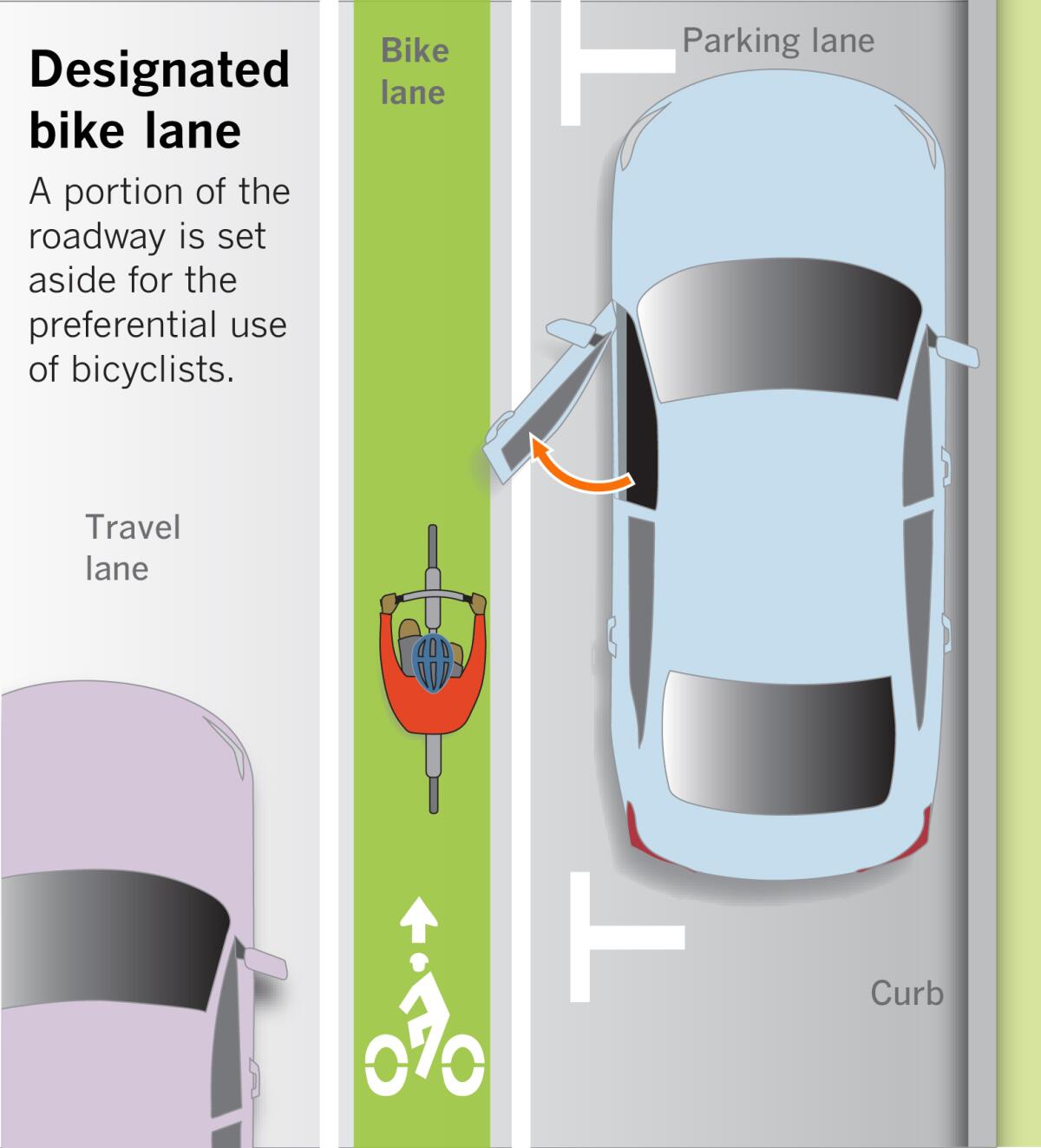
(Paul Duginski / Los Angeles Times)
However, Madeline Brozen, deputy director of the UCLA Lewis Center for Regional Policy Studies, points to “protective infrastructure” as a means for better bicycle safety.
“You’re having some type of physical protection between where people are riding bikes and moving traffic,” she said, “but sometimes that can even go further in terms of using parked cars as the actual protection.”
These parking-protected bike lanes, similar to those found in Downtown L.A. between Main Street and East 8th Street, contain buffer zones that separate cyclists from parked cars and oncoming traffic.
Reevaluating bike lanes is a matter of geometry, Brozen said, as well as the “political battle over convenience or delay for vehicles over the safety of people biking and walking.”
“It’s really at the whim of the council member and the council member’s office to decide whether they’re willing to take on those battles or not,” Brozen said.
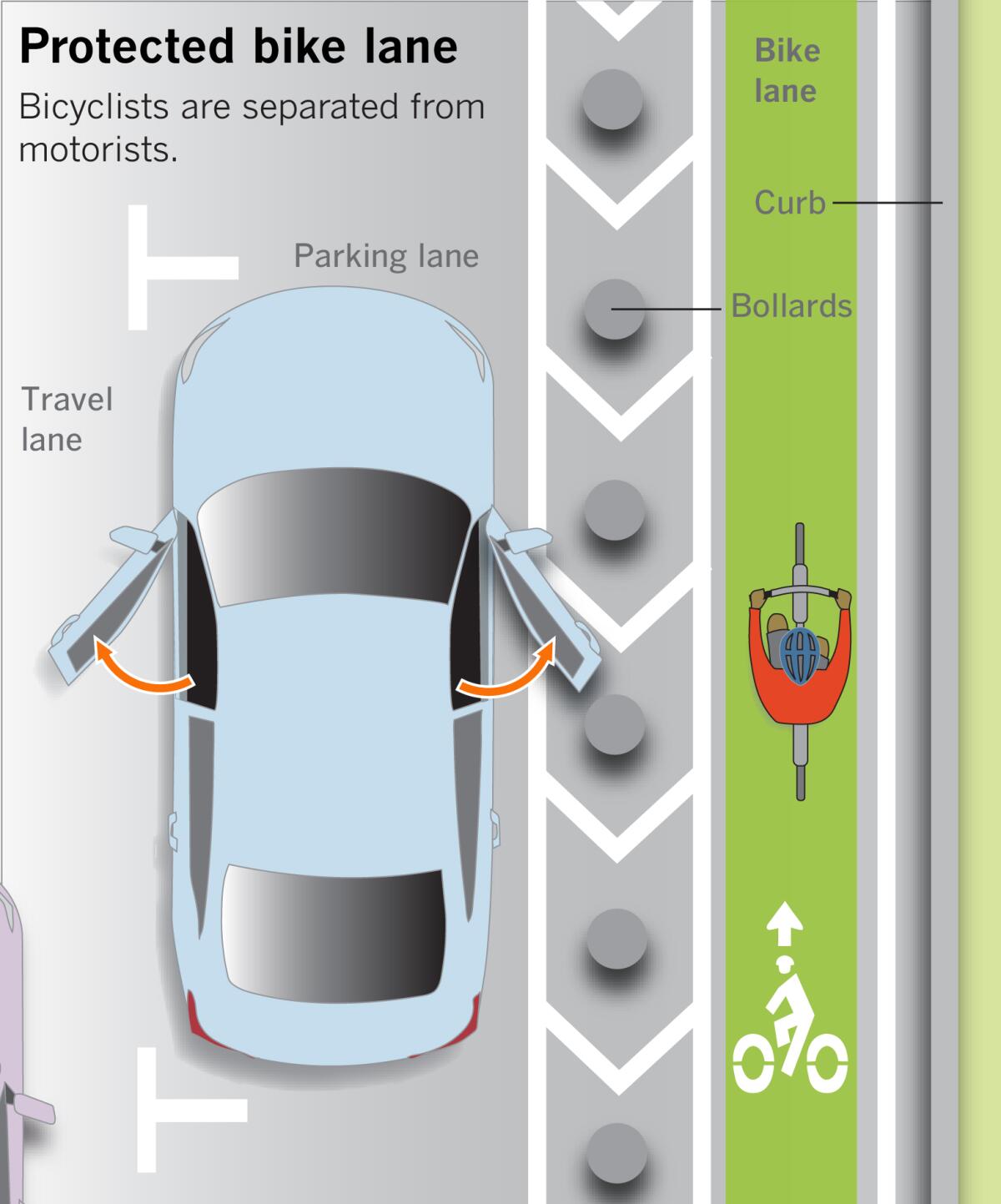
(Paul Duginski / Los Angeles Times)
At the very least, Diaz wishes there were more painted bike lanes in L.A. Or that drivers were more understanding of non-motorists on the road.
“As soon as we get behind a wheel, we become different people,” she said. “Suddenly, you have to get to where you’re going as fast as possible.”
Three weeks after George’s death, Diaz and her sister-in-law Jennifer George held a ghost bike vigil at the collision site. Along with a white bike, the memorial is adorned with bougainvillea, a plaque with George’s name and a sign on a street pole.
Diaz wants people to know what happened on this street, so the sign recounts the events that occurred on Oct. 17.
It then adds, “Please watch out for bicyclists.”
Source link













